Working for Wausau
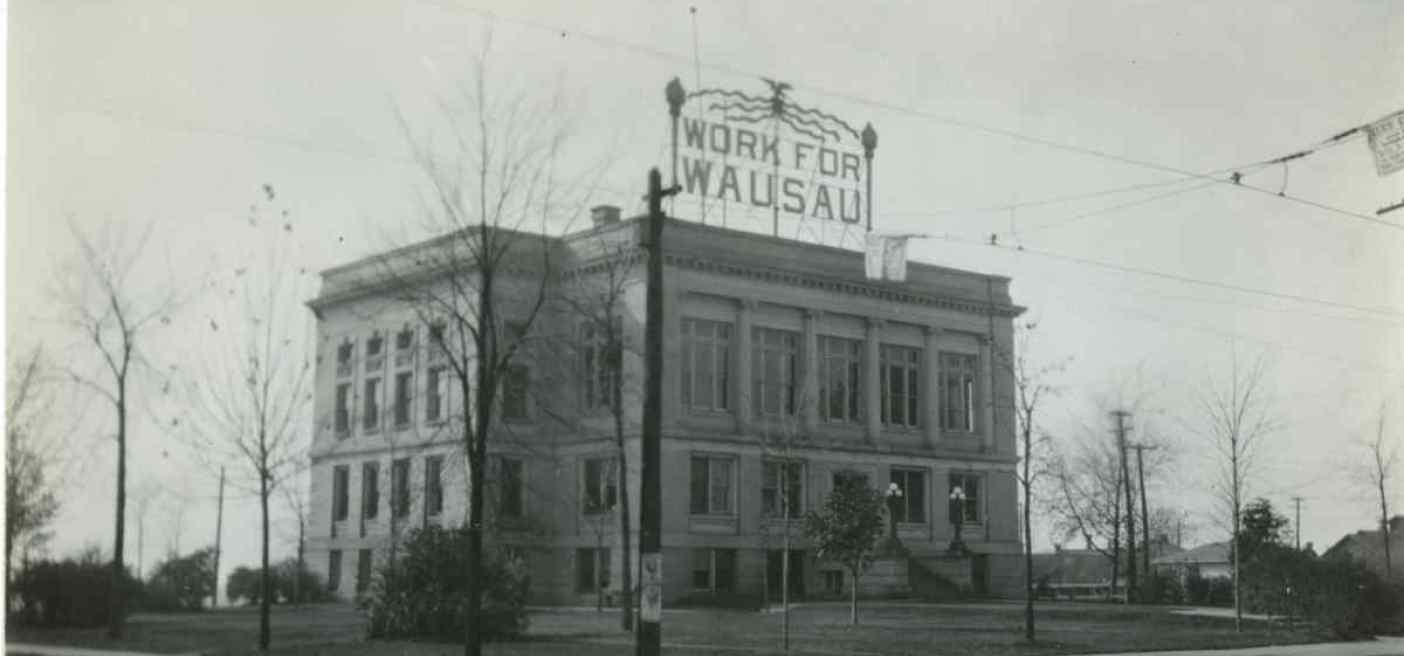
On June 9th, 1914, over 12,000 people gathered in downtown Wausau for the unveiling of a new sign over the city hall. The new sign stood thirty feet tall, with hundreds of electric lights to illuminate the massive letters that spelled out the new city slogan: WORK FOR WAUSAU.
Earlier in the year, the Wausau Advancement Association (a precursor to the Chamber of Commerce) solicited suggestions for a slogan, with the idea of using it to boost the profile of the city of Wausau. In May they met and chose Charles Turner’s “Work for Wausau” out of over a hundred submissions. They then made arrangements for the massive sign to be built on the roof of the city hall and for it to be illuminated in the night sky.
Furthermore, photographs of the sign and city hall were taken to distribute across the nation and plans were made to create buttons for Wausau men and women to wear while traveling in order to help them boost Wausau.
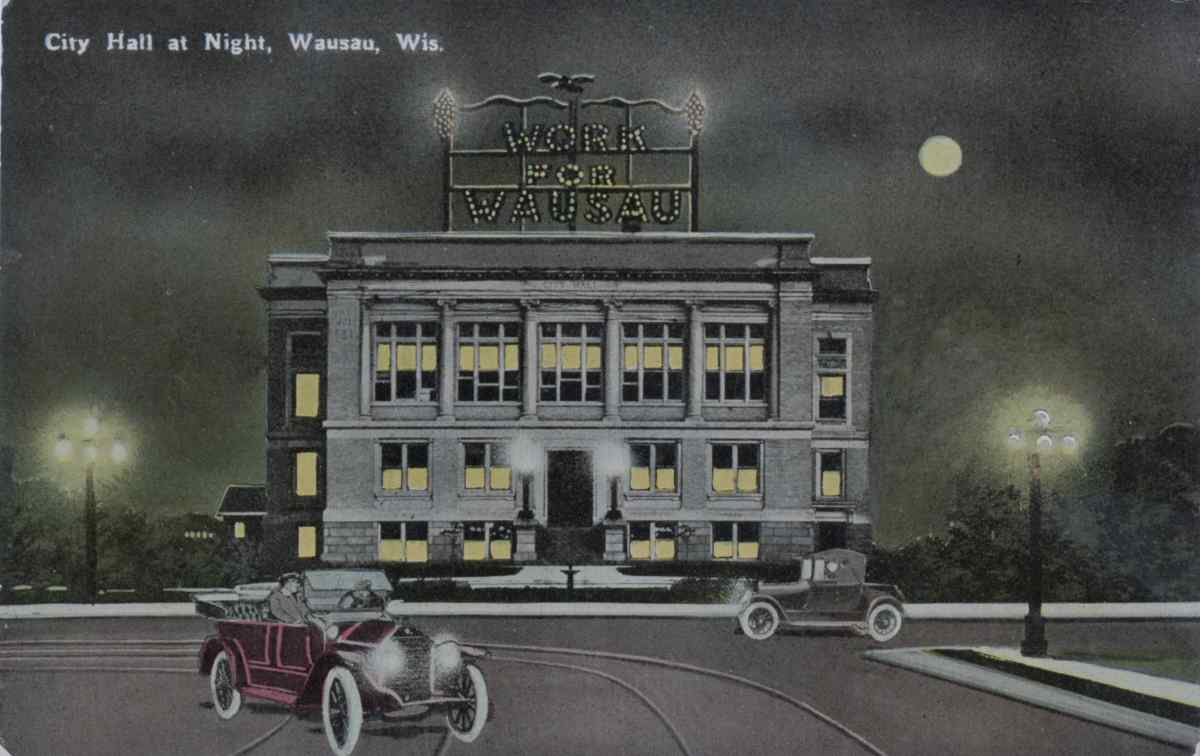
^ Postcard showing the Wausau City Hall illuminated at night. From the MCHS Photo Archives.
How to "Work for Wausau"
But the idea that all citizens should “work for Wausau”–while it had a nice ring to it—was not necessarily clear how Wausau's citizens were expected to work for Wausau. Perhaps as a result, the phrase was adopted for a variety of different purposes by the people and businesses of Wausau.
At the ceremony unveiling the sign, Mark Ewing explained that the sign (and slogan) should serve as a lesson to the citizens of Wausau, to do as the pioneers had, and put aside personal differences in order to come together and “build and maintain Wausau as a metropolis of the Wisconsin Valley.”
Businesses regularly used the slogan in their advertisements with the message (sometimes implied, sometimes spelled out) that the best way to “work for Wausau” was to patronize their shops and buy from local companies. This would after all help keep local companies in business, which would be for the benefit for all of Wausau.
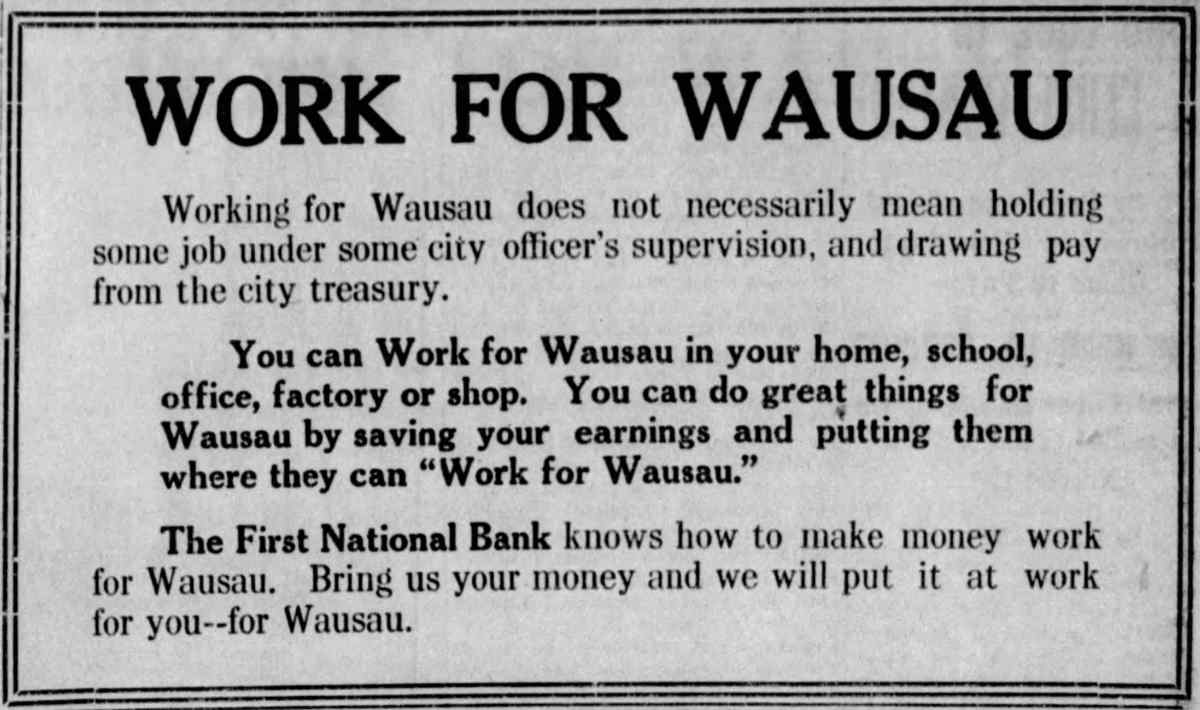
In June of 1914 alone, the "work for Wausau" slogan was used in ads for companies as diverse as banks, lumber mills and vendors, insurance companies, canneries, automobile garages, furniture makers, and producers of granite monuments, bags of flour, and cement sidewalks.
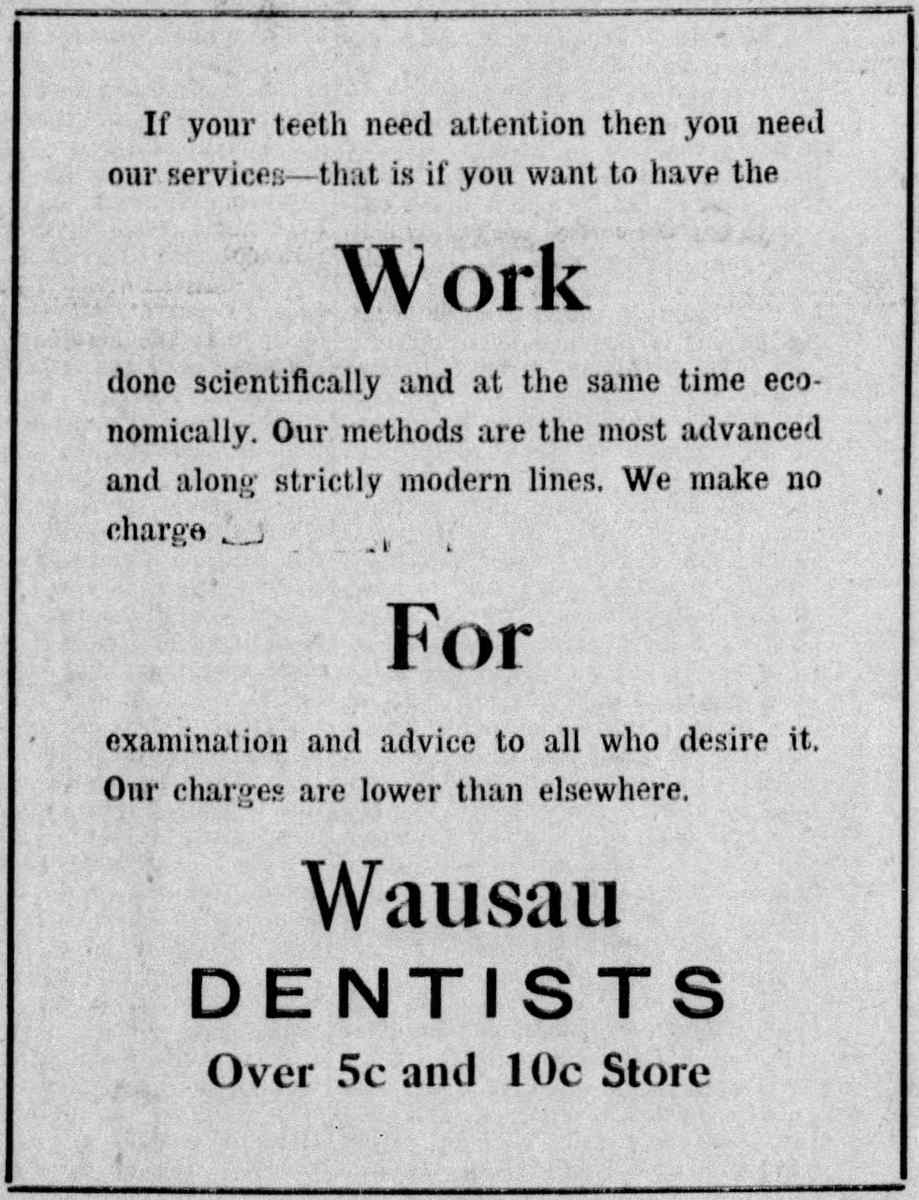
Naturally politicians also adopted the slogan as part of their campaigning. For example, in 1922 Helen Ohm pledged she would “work for Wausau” in her successful campaign to become the first female to be elected to the city council.
Since every public office seeker has a so-called platform mine can be summed up briefly in these words, ‘Work for Wausau.' Let our spirit of helpfulness and service to the community overshadow our own selfish ends and individual desires and make that sign above the city hall stand for more than a glittering array of electric lights.
-Helen Ohm in the Wausau Daily Herald, February 7, 1922
The phrase was even used to support arguments against organized labor. In one paid column in the Wausau Daily Herald, “Open Shop News,” the argument was regularly made that workers would be better off not joining unions. One such article argued that belonging to a union will always mean the possibility of striking; a strike would mean halting production at a factory; and reduced production would hurt the city in the short and long run. They also implied that even the perception that there might be organized labor here would mean businesses would want to leave or avoid setting up shops in Wausau. The not-so-subtle implication being that anyone who joined a union wasn’t working for Wausau.
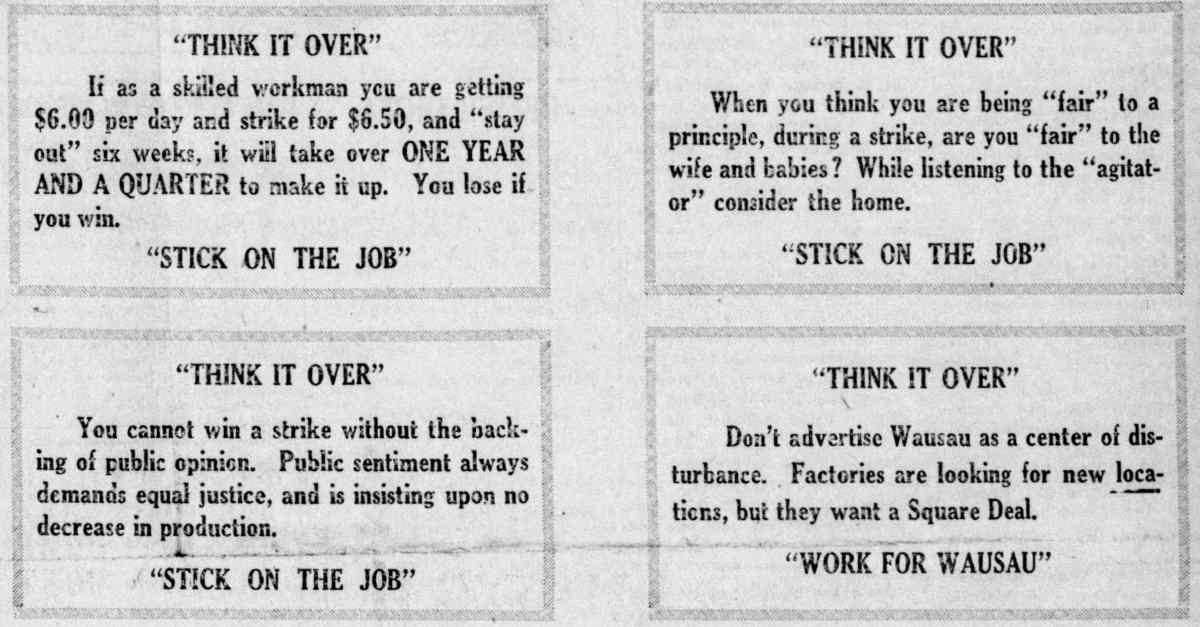
^ A section of the paid collumn, "Open Shop News" that appeared in the April 3, 1920 edition of the Wausau Daily Herald. The sections were paid advertisements in the guise of a collumn, and although the author tried to present himself as neither pro-labor nor anti-labor, his low opinion of Unions was clear in most of the pieces.
Ultimately, it didn’t really matter how you interpreted the phrase, the city happily used the slogan as a byword for civic pride. In 1925 Mayor Emil Flatter proclaimed the 11th to the 16th of October, “Work for Wausau Week.” The week was dedicated to celebrating all that Wausau was and could become. Events planned for the week included sermons at churches, the showing of a special movie at the Grand Theatre, the crowning of a “Miss Wausau,” an essay contest for students, and culminated with a large parade—all designed to highlight the civic accomplishments of Wausau.
Reevaluating the Slogan
But by the end of the 1920s, the slogan was starting to become a liability, particularly as viewed by those outside Wausau. As read from the outside, the phrase “work for Wausau” seemed to be a campaign to attract workers away from other communities. At the least it was certainly seen as boastful in a way that was no longer as fashionable. It was not long before other groups adopted the phrase to criticize Wausau.
After being pulled over for speeding near Wausau, one vacationing Chicagoan returned home to write an editorial in the Chicago Tribune, in which he suggested that if people really wanted to do some positive “work for Wausau” they should rein in what he saw as over-zealous patrolmen in Schofield.
In 1927, an angry column in the Stratford Journal singled out the slogan as an example of the alienating attitudes of the politicans in Marathon County. If the officials in the County seat were going to focus on working for Wausau, he suggested the western half of the County should secede from Wausau to form a new County.
Perhaps more lightheartedly, fans of the Antigo baseball team (rivals of the Wausau Lumberjacks) would complain about calls during a game by suggesting the umpires were working a little too hard for Wausau.
Ultimately the slogan soured even to the people of Wausau. Particularly in the aftermath of the stock market crash in 1929, the huge sign admonishing citizens to “work for Wausau” felt a more than a little hollow given the difficulties of the deepening Great Depression when many were laid off from their jobs. It was diffcult to ask the citizens of Wausau to rejoice in all they had at a time when many were having to do without so much.
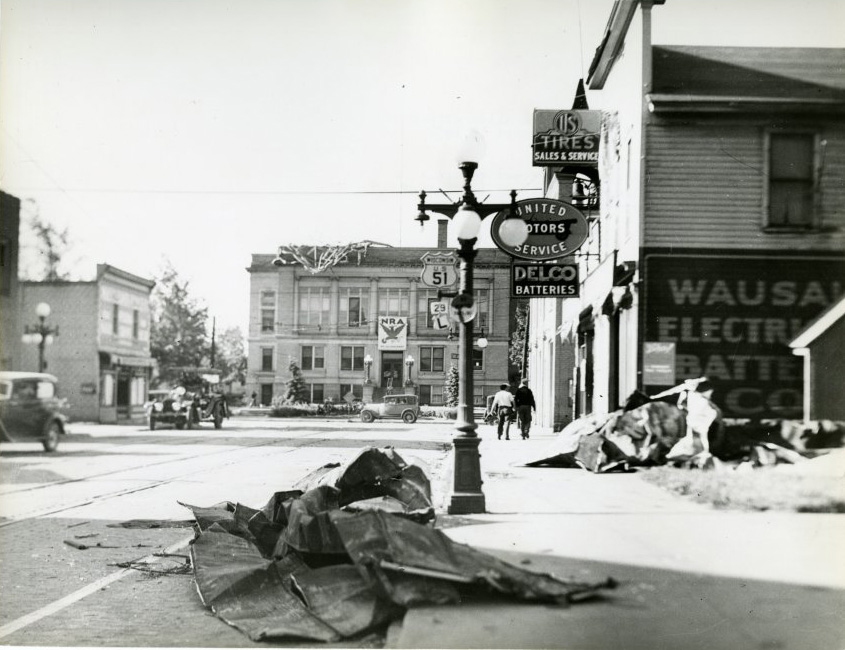
^ Downtown Wausau in the aftermath of a major wind storm, 1934. From the MCHS Photo Archives.
Final Years
In 1931 the Chamber of Commerce decided that the slogan had served its purpose, and in September the sign over city hall was modified so that it read “Welcome to Wausau."
The phrase "Work for Wausau" was still said occasionally over the 1930s—both to criticize the state of Wausau's industries and to appeal for city leaders to "correct conditions" to revive them—but the slogan gradually faded from use after it was replaced on the roof of city hall.
The new words of welcome shown down from 3rd Street for another three years until 1934, when a severe storm hit Wausau—flattening the scaffolding and twisting the bolts that once held it up.
The austerity during the Great Depression put a damper on the boosterism of the 1910s and 1920s, and no sign was built to replace the old one in proclaim Wausau's greatness.
